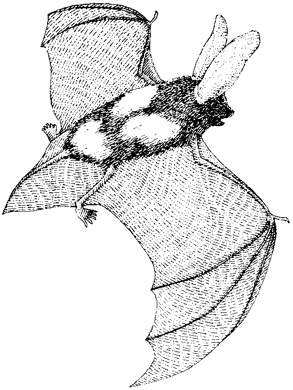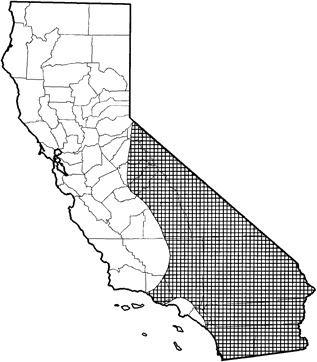
Spotted Bat
Distribution, Abundance, and Seasonality
The spotted bat, considered to be one of North America's rarest mammals (IUCN 1972-78), has been found at a small number of localities, mostly in foothills and mountains and desert regions of southern California (Watkins 1977). Occasionally occurs outside this range. Little is known about the species in California. Habitats occupied range from arid deserts and grasslands through mixed conifer forests. The highest recorded elevation, 3230 m (10,600 ft), is in New Mexico (Reynolds 1981).

Range Map
Specific Habitat Requirements
Feeding: Moths are the principal food. There is some evidence of beetle consumption. Feeds in flight, over water, and near the ground, using echolocation to find prey.
Cover: Apparently prefers to roost in rock crevices. Occasionally found in caves and buildings. Cliffs provide optimal roosting habitat.
Reproduction: Probably uses rock crevices.
Water: Drinks water, but has high ability to concentrate urine compared to bats of mesic habitats (Geluso 1978).
Pattern: Prefers sites with adequate roosting habitat, such as cliffs. Feeds over water and along washes. May move from forests to lowlands in autumn.
Species Life History
Activity Patterns: Nocturnal. This species is a late flyer; most captures are after midnight. Capable of torpor; hibernates in some areas.
Seasonal Movements / Migration: May make local movements in some areas, from high elevations in summer to lower elevations in autumn. Little is known about the California populations; may be yearlong residents, or migratory.
Home Range: No data found.
Territory: Apparently solitary. Four individuals were observed hibernating together.
Reproduction: Mates in autumn. Most births occur before mid-June. Lactating females reported from June to August. One young is produced per year.
Niche: May be found foraging with many other species. Appears to be a moth specialist. Rabies have been reported in California (Medeiros and Heckman 1971).
Comments: Apparently rare in California. An increasing number of recent reports have occurred in British Columbia, Utah, and Texas. Solitary, crevice-roosting habits make this species difficult to find.
Sources & References
California Department of Fish and Game, 1999.
California's Wildlife, Sacramento, CA.
Written by: J. Harris, reviewed by: P. Brown, edited by: D. Alley, R. Duke
Constantine, D. G. 1961. Spotted bat and big free-tailed bat in northern New Mexico. Southwest. Nat. 6:92-97. Easterla, D. A. 1965. The spotted bat in Utah. J. Mammal. 46:665-668. Easterla, D. A. 1971. Notes on young and adults of the spotted bat, Euderma maculatum. J. Mammal. 52:475-476. Easterla, D. A. 1973. Ecology of the 18 species of Chiroptera at Big Bend National Park, Texas. Northwest Mo. State Univ. Studies 34:1-165. Easterla, D. A., and J. O. Whitaker, Jr. 1972. Food habits of some bats from Big Bend National Park, Texas. J. Mammal. 53:997-890. Findley, J. S., and C. Jones. 1965. Comments on spotted bats. J. Mammal. 46:679-680. Geluso, K. N. 1978. Urine concentrating ability and renal structure of insectivorous bats. J. Mammal. 59:312-323. Handley, C. O., Jr. 1959. A revision of American bats of the genera Euderma and Plecotus. Procs. U.S. Nat. Mus. 110:95-246. International Union for Conservation of Nature and Natural Resources. 1972-1978. Red data book. I. Mammalia. Morges, Switzerland. Medeiros, J. L., and R. A. Heckmann. 1971. Euderma maculatum from California infected with rabies virus. J. Mammal. 52:858. Poche, R. M., and G. L. Bailie. 1974. Notes on the spotted bat (Euderma maculatum) from southwest Utah. Great Basin Nat. 34:254-256. Reynolds, R. P. 1981. Elevational record for Euderma maculatum (Chiroptera: Vespertilionidae). Southwest. Nat. 26:91-92. Ross, A. 1961. Notes on food habits of bats. J. Mammal. 42:66-71. Stager, K. K. 1957. Records of the spotted bat from California and Arizona. J. Mammal. 38:260. Watkins, L. C. 1977. Euderma maculatum. Mammal. Species No. 77. 4pp.
California Animal Facts | California's Wildlife